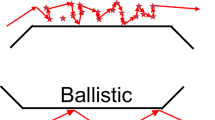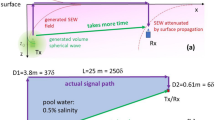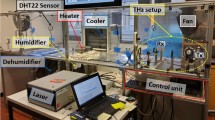Abstract
WHEN a wireless wave is received partly or wholly by way of the ionosphere, it is observed to fade. Much of this fading is due to interference effects between waves which have travelled by different paths. Such waves may include the ground wave, singly or multiply reflected ionospheric waves, waves reflected from different ionospheric regions, or the two magneto-ionic components produced by the presence of the earth‘s magnetie field. It is, however, possible to isolate and observe only one downcoming wave from the ionosphere, for example, by the use of a pulse sender and a circularly polarized receiving aerial or by the use of a special aerial to suppress the ground wave under conditions when the absorption of the downcoming Wave is large enough to make second reflexions unimportant. When only one downcoming wave is observed in this way, it is still found to fade at a speed which varies from time to time. Although few detailed observations of this kind of fading have been reported, workers in the subject will probably accept the general statement that the speed of fading is roughly proportionai to the frequency of the wave and inversely proportional to the distance of the transmitter1.
This is a preview of subscription content, access via your institution
Access options
Subscribe to this journal
Receive 51 print issues and online access
$199.00 per year
only $3.90 per issue
Buy this article
- Purchase on Springer Link
- Instant access to full article PDF
Prices may be subject to local taxes which are calculated during checkout
Similar content being viewed by others
References
Appleton, E. V., and Ratcliffe, J. A., Proc. Roy. Soc., A, 115, 315 (1927).
Ratcliffe, J. A., and Pawsey, J. L., Proc. Camb. Phil. Soc., 29, 301 (1933).
Pawsey, J. L., Proc. Camb. Phil. Soc., 31, 125 (1935).
Fürth, R., and MacDonald D. K. C., Proc. Phys. Soc., 59, 388 (1947).
Findlay, J. W., Nature, 159, 58 (1947).
Best, J. E., Ratcliffe, J. A., and Wilkes, M. V., Proc. Roy. Soc., A, 156, 614 (1936).
Budden, K. G., Ratcliffe, J. A., and Wilkes, M. V., Proc. Roy. Soc., A, 171, 188 (1939).
Author information
Authors and Affiliations
Rights and permissions
About this article
Cite this article
RATCLIFFE, J. Diffraction from the Ionosphere and the Fading of Radio Waves. Nature 162, 9–11 (1948). https://doi.org/10.1038/162009a0
Issue Date:
DOI: https://doi.org/10.1038/162009a0
This article is cited by
-
Distribution-in-Speed of Fading of 150-kc./s. Waves
Nature (1955)
-
Winde und turbulente Luftströmungen in der Ionosphäre
Archiv für Meteorologie, Geophysik und Bioklimatologie Serie A (1954)
-
Direction of Arrival of Ionospheric Radio Waves
Nature (1950)
-
Atmospheric Effects on Short-Wave Radio Propagation
Nature (1949)
-
Tilts in the Ionosphere
Nature (1949)
Comments
By submitting a comment you agree to abide by our Terms and Community Guidelines. If you find something abusive or that does not comply with our terms or guidelines please flag it as inappropriate.



